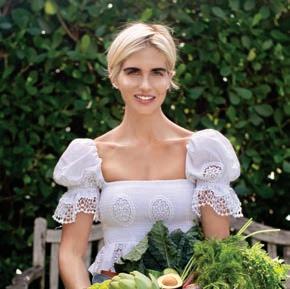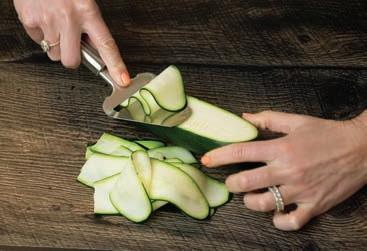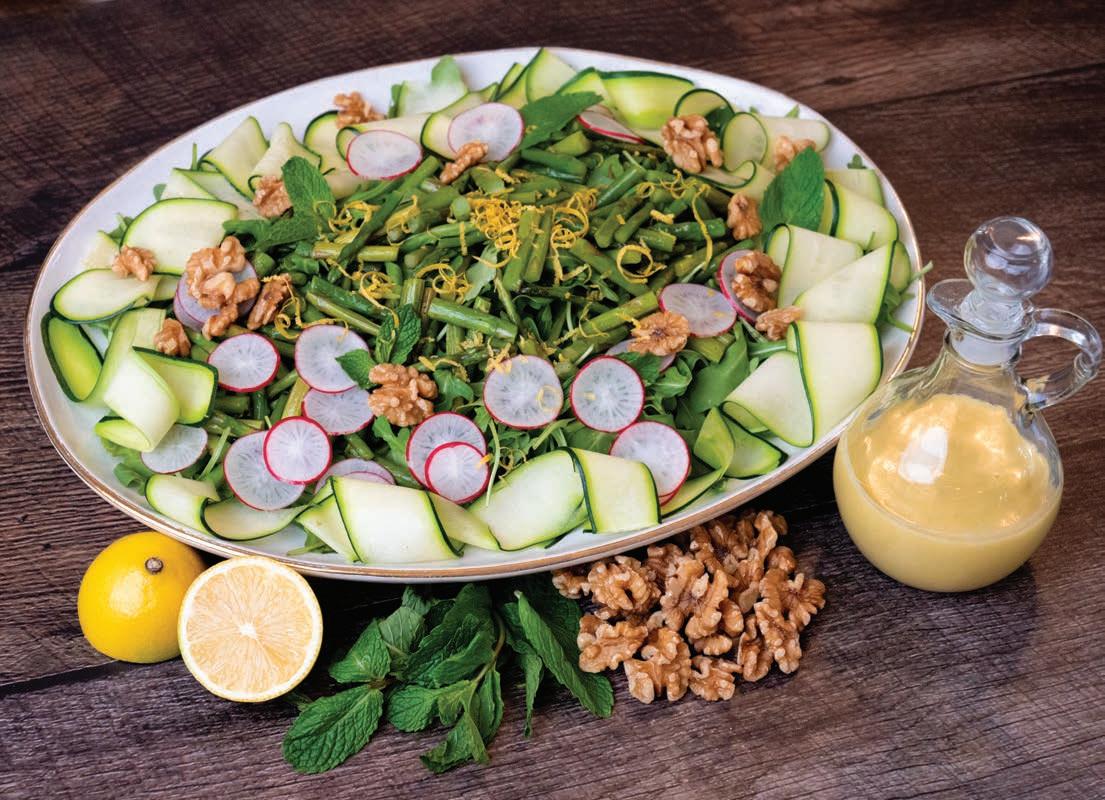
4 minute read
LIVING WITH IVEY
LIVING WITH IVEY All About PRODUCE
The dirt on pesticides and the war of organic versus conventional
By Ivey Leidy Photography by Kent Anderson
Research has long shown that pesticide residue can contribute to health issues. These chemicals act as endocrine disruptors, meaning that when they enter the body they can be mistaken as hormones, mimicking and disrupting the endocrine system.
The endocrine system is an intricate network of glands and organs that produce hormones that carry out the majority of our bodily functions. The hormones act as messengers to our brains and the rest of our organs and evoke corresponding responses. The hypothalamus gland, for example, controls water balance, sleep, temperature, appetite, and blood pressure. The thyroid is responsible for our metabolism, while the pancreas takes care of digestion and produces insulin to regulate blood sugar. The endocrine system also includes our reproductive organs, as well as our pituitary, pineal, thymus, and adrenal glands.
When faced with disruptors, the signals from our endocrine system can become mixed, affecting everything from metabolism to reproductive health. With chronic exposure, they may cause serious health issues. Pesticides collect over time and are stored in the colon. That one piece of conventional fruit is not the problem, but the buildup is. The best way to limit your exposure to pesticides is to choose organic.
Almost 70 percent of produce in the U.S. contains pesticides. Luckily, the Environmental Working Group (EWG) releases two lists every year: the Dirty Dozen and the Clean 15. The Dirty Dozen covers the conventional produce that carries the most pesticide residue. No. 1 on the list is strawberries. Studies show that one strawberry can have residue from 20 different pesticides. The Clean 15 outlines the conventional produce that is least likely to contain pesticides.
The benefits of eating organic don’t end at reduced pesticide exposure. Organic produce has 20 percent more antioxidants than conventional and no GMOs (genetically modified organisms), making them easier to digest and their nutrients easier to absorb. Organic farming also produces less greenhouse gas emissions and better soil quality as it doesn’t result in pollution from run-off pesticides.
Eating in season can also help you get the most out of your produce. Because it’s being picked at peak ripeness, in-season produce has better flavor. These items are less expensive, given their abundance. They’re also significantly more nutrient dense as they aren’t being transported for weeks. Remember: The longer a fruit or vegetable sits on a truck or shelf, the more nutrient loss. We, as humans, are designed to eat seasonally. In the fall and winter, fruits and vegetables rich in vitamin C grow to strengthen our immunity. In the spring and summer, moisture-packed fruits and vegetables grow to ensure we are hydrated.
Read on for more helpful produce insight by the bite, as well as my recipe for a beautiful seasonal vegetable salad.



SPRING VEGETABLE SALAD

THIS IN-SEASON, ORGANIC VEGETABLE SALAD MAXIMIZES NUTRIENTS AND ENHANCES HYDRATION
INGREDIENTS 3 large handfuls of baby lettuces (such as, arugula or mixed greens) 1 large zucchini 2 radishes 1 bunch of asparagus, roughly chopped 1 tbsp. olive oil 2 tbsp. water 1/4 cup fresh mint Zest of 1/2 lemon 1/4 cup walnuts
LEMON VINAIGRETTE INGREDIENTS 2 tbsp. lemon juice (1/2 lemon) 1 tbsp. Dijon mustard 1 tsp. raw honey 1/2 shallot, thinly sliced and minced (optional) 1/4 cup olive oil Salt and pepper to taste
Whisk together all ingredients, adding in olive oil last and gradually to emulsify.
SHOPPING TIPS
1. Organic produce is labeled with a five-digit code beginning with nine. 2. Conventional produce is labeled with a four-digit code beginning with a three or four. 3. If the skin/husk is thick and tough like an avocado or a banana, it can be eaten conventionally, as the pesticide sprays are less likely to penetrate that thick skin.
In a lidded sauté pan, add the asparagus, olive oil, and water. Cook on medium for 5 minutes with lid on or until tender but still vibrant and green. Using a vegetable peeler, peel zucchini into ribbons. Using a mandolin or sharp knife, thinly slice the radishes.
Arrange salad beginning with baby greens. Add cooked asparagus to the center. Arrange zucchini ribbons and radishes around the asparagus. Garnish with mint leaves, lemon zest. and walnuts. Drizzle with lemon vinaigrette.
THE DIRTY DOZEN 1. Strawberries 2. Spinach 3. Kale 4. Nectarines 5. Apples 6. Grapes 7. Peaches 8. Cherries 9. Pears 10. Tomatoes 11. Celery 12. Potatoes

THE CLEAN 15 1. Avocado 2. Sweet corn 3. Pineapple 4. Onions 5. Papaya 6. Frozen sweet peas 7. Eggplant 8. Asparagus 9. Cauliflower 10. Broccoli 11. Cantaloupe 12. Mushrooms 13. Cabbage 14. Honeydew melon 15. Kiwi FLORIDA’S IN-SEASON SPRING & SUMMER PRODUCE 1. Asparagus 2. Bell peppers 3. Blueberries 4. Cabbage 5. Cantaloupe 6. Carrots 7. Celery 8. Cucumber 9. Eggplant 10. Grapefruit 11. Mushrooms 12. Papaya 13. Peaches 14. Potatoes 15. Radishes 16. Spinach 17. Sweet corn 18. Tomatoes 19. Watermelon 20. Zucchini
l GET IVEY’S RECIPE FOR A BLOOD ORANGE MARGARITA AT PALMBEACHILLUSTRATED.COM/ BLOODORANGEMARGARITA











